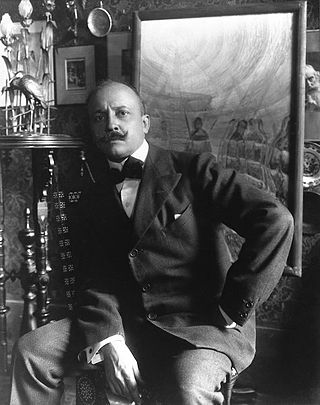
Filippo Tommaso Emilio Marinetti was an Italian poet, editor, art theorist, and founder of the Futurist movement. He was associated with the utopian and Symbolist artistic and literary community Abbaye de Créteil between 1907 and 1908. Marinetti is best known as the author of the Manifesto of Futurism, which was written and published in 1909, and as a co-author of the Fascist Manifesto, in 1919.

Futurism was an artistic and social movement that originated in Italy, and to a lesser extent in other countries, in the early 20th century. It emphasized dynamism, speed, technology, youth, violence, and objects such as the car, the airplane, and the industrial city. Its key figures included Italian artists Filippo Tommaso Marinetti, Umberto Boccioni, Carlo Carrà, Fortunato Depero, Gino Severini, Giacomo Balla, and Luigi Russolo. Italian Futurism glorified modernity and, according to its doctrine, "aimed to liberate Italy from the weight of its past." Important Futurist works included Marinetti's 1909 Manifesto of Futurism, Boccioni's 1913 sculpture Unique Forms of Continuity in Space, Balla's 1913–1914 painting Abstract Speed + Sound, and Russolo's The Art of Noises (1913).
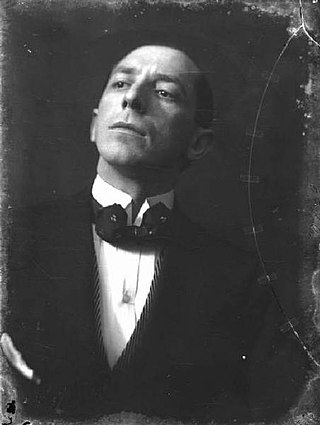
Umberto Boccioni was an influential Italian painter and sculptor. He helped shape the revolutionary aesthetic of the Futurism movement as one of its principal figures. Despite his short life, his approach to the dynamism of form and the deconstruction of solid mass guided artists long after his death. His works are held by many public art museums, and in 1988 the Metropolitan Museum of Art in New York City organized a major retrospective of 100 pieces.

Gino Severini was an Italian painter and a leading member of the Futurist movement. For much of his life he divided his time between Paris and Rome. He was associated with neo-classicism and the "return to order" in the decade after the First World War. During his career he worked in a variety of media, including mosaic and fresco. He showed his work at major exhibitions, including the Rome Quadrennial, and won art prizes from major institutions.

Italian futurist cinema was the oldest movement of European avant-garde cinema. Italian futurism, an artistic and social movement, impacted the Italian film industry from 1916 to 1919. It influenced Russian Futurist cinema and German Expressionist cinema. Its cultural importance was considerable and influenced all subsequent avant-gardes, as well as some authors of narrative cinema; its echo expands to the dreamlike visions of some films by Alfred Hitchcock.

Fortunato Depero was an Italian futurist painter, writer, sculptor, and graphic designer.

Futurist architecture is an early-20th century form of architecture born in Italy, characterized by long dynamic lines, suggesting speed, motion, urgency and lyricism: it was a part of Futurism, an artistic movement founded by the poet Filippo Tommaso Marinetti, who produced its first manifesto, the Manifesto of Futurism, in 1909. The movement attracted not only poets, musicians, and artists but also a number of architects. A cult of the Machine Age and even a glorification of war and violence were among the themes of the Futurists - several prominent futurists were killed after volunteering to fight in World War I. The latter group included the architect Antonio Sant'Elia, who, though building little, translated the futurist vision into an urban form.
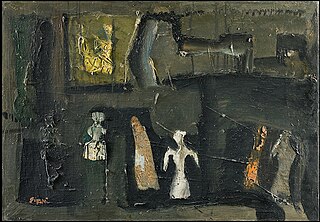
Mario Sironi was an Italian Modernist artist who was active as a painter, sculptor, illustrator, and designer. His typically somber paintings are characterized by massive, immobile forms.
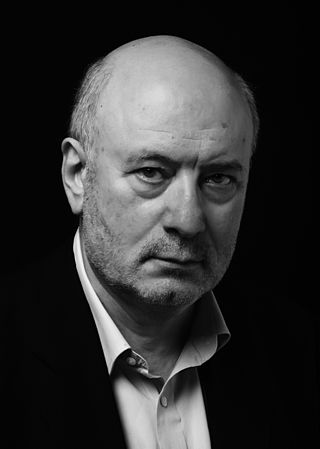
Giovanni Lista is an Italian art historian and art critic, resides in Paris. He is a specialist in the artistic cultural scene of the 1920s, particularly in Futurism.
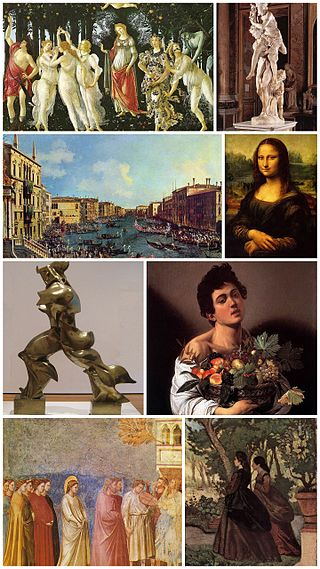
Italian Contemporary art refers to painting and sculpture in Italy from the early 20th century onwards.

Aeropittura (Aeropainting) was a major expression of the second generation of Italian Futurism, from 1929 through the early 1940s. The technology and excitement of flight, directly experienced by most aeropainters, offered aeroplanes and aerial landscape as new subject matter.
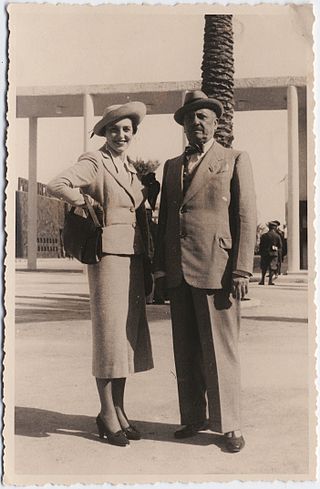
Benedetta Cappa was an Italian futurist artist who has had retrospectives at the Walker Art Center and the Solomon R. Guggenheim Museum. Her work fits within the second phase of Italian Futurism.

Girl Running on a Balcony is a 1912 painting by Giacomo Balla, one of the forerunners of the Italian movement called Futurism. The piece indicates the artist's growing interests in creative nuances which would later formally be realized as part of the Futurist movement. The artist was heavily influenced by northern Italians' use of Divisionism and the French's better-known pointillism. Created with oil on canvas just on the brink of World War I, the Futurist movement is embodied by a dark optimism for a future of speed, turbulence, chaos, and new beginnings. Most of Giacaomo Balla's pieces allude to the wonder of dynamic movement, and this painting is no exception. The oil painting is now in the Museo del Novecento, in Milan.
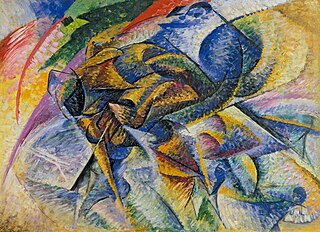
Dynamism of a Cyclist is a 1913 oil painting by Italian Futurist artist Umberto Boccioni (1882–1916) that demonstrates the Futurist fascination with speed, modern methods of transport, and the depiction of the dynamic sensation of movement.
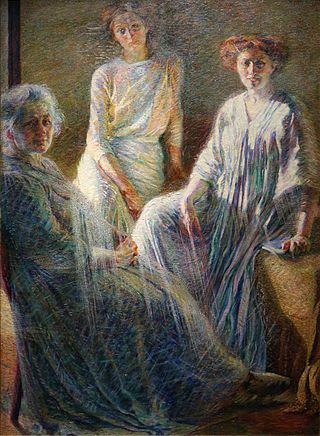
Three Women is a painting by Italian artist Umberto Boccioni, executed between 1909 and 1910. This painting is oil on canvas painted in the style of divisionism. Divisionism refers to the actual division of colors by creating separated brush strokes as opposed to smooth, solid lines. The painting contains three figures, one being Boccioni's mother Cecilia on the left, another being his sister, Amelia on the right, and the third being Ines, his lover, in the center.
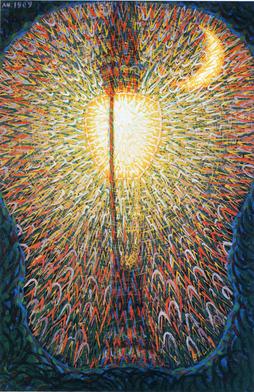
Street Light (also known as The Street Light: Study of Light and Street Lamp (Suffering of a Street Lamp)) (Italian: Lampada ad arco) is a painting by Italian Futurist painter Giacomo Balla, dated 1909, depicting an electric street lamp casting a glow that outshines the crescent moon. The painting was inspired by streetlights at the Piazza Termini in Rome.

Dynamism of a Dog on a Leash, sometimes called Dog on a Leash or Leash in Motion, is a 1912 oil painting by Italian Futurist painter Giacomo Balla. It was influenced by the artist's fascination with chronophotographic studies of animals in motion. It is considered one of his best-known works, and one of the most important works in Futurism, though it received mixed critical reviews. The painting has been in the collection of the Buffalo AKG Art Museum since 1984.
Iridescent Interpenetration is the title of several artworks and studies in a series by Italian Futurist painter Giacomo Balla, created between 1912 and 1914, which feature intersecting triangles and other geometric patterns in kaleidoscopic color.

Růžena Zátková, also called Rougina Zatkova, was a painter and sculptor who has been regarded as the "only authentic Czech futurist." As a result of her Bohemian heritage and her decade-long residency in Rome, Růžena Zátková became an important artistic link between Russian and Italian Futurism. Zátková is considered one of the pioneers of kinetic art.

Dynamism of a Human Body: Boxer is a 1913 dynamism drawing created by the futurist Italian artist Umberto Boccioni. The work was intended to show a subject in between a state of motion and stillness.




















